Kefir is a fermented beverage often compared to yogurt. This healthy drink offers plenty of health benefits, from improved digestion to blood sugar management. There are different types of kefir, and as a fermented milk drink, it provides health benefits for many people but may not be appropriate for some.
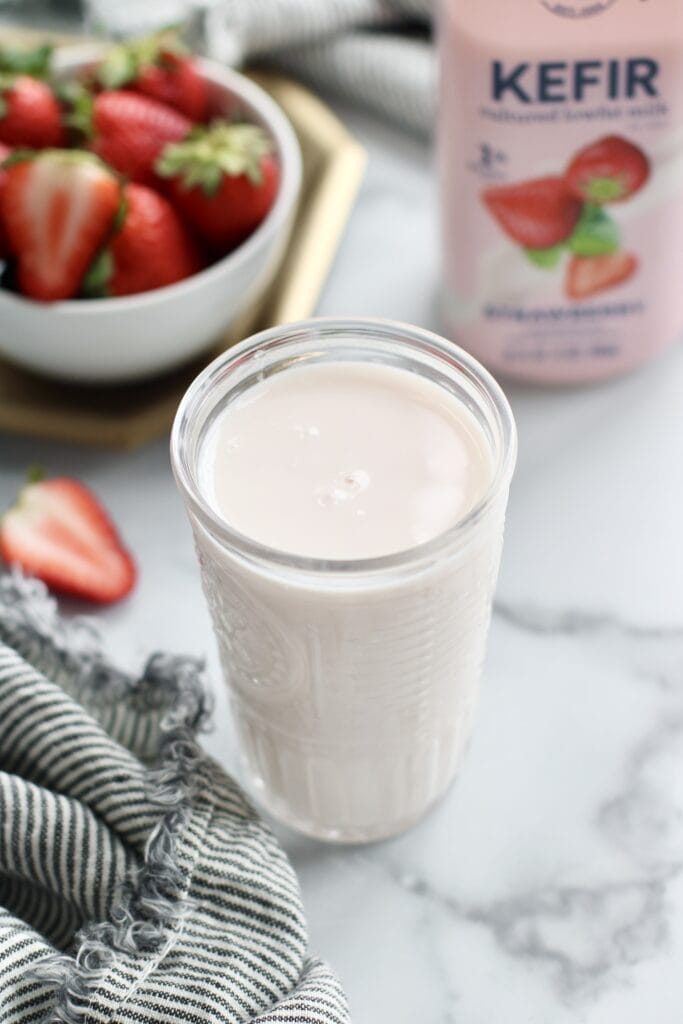
Want to save this page?
Enter your email below & we’ll send it straight to your inbox. Plus you’ll get great new recipes from us every week!
What Is Kefir?
Kefir is a probiotic beverage made by adding kefir grains to milk. Kefir ‘grains’ are actually not grains at all, but rather solid pieces made from previous batches of kefir. But they do resemble small bits of rice, which is why they’re referred to as grains. These grains contain bacteria and yeast that feed off of the lactose in milk in order to ferment.
This is known as the fermentation process — the same process that can turn tea into kombucha or cabbage into sauerkraut.
Sometimes referred to as “drinkable yogurt,” kefir is a smooth creamy gluten-free fermented drink that has a pleasant tart-sour taste. It’s slightly effervescent and rich in gut-friendly bacteria. It’s much lower in lactose than fresh milk and many other dairy products, though it is not 100% lactose-free.
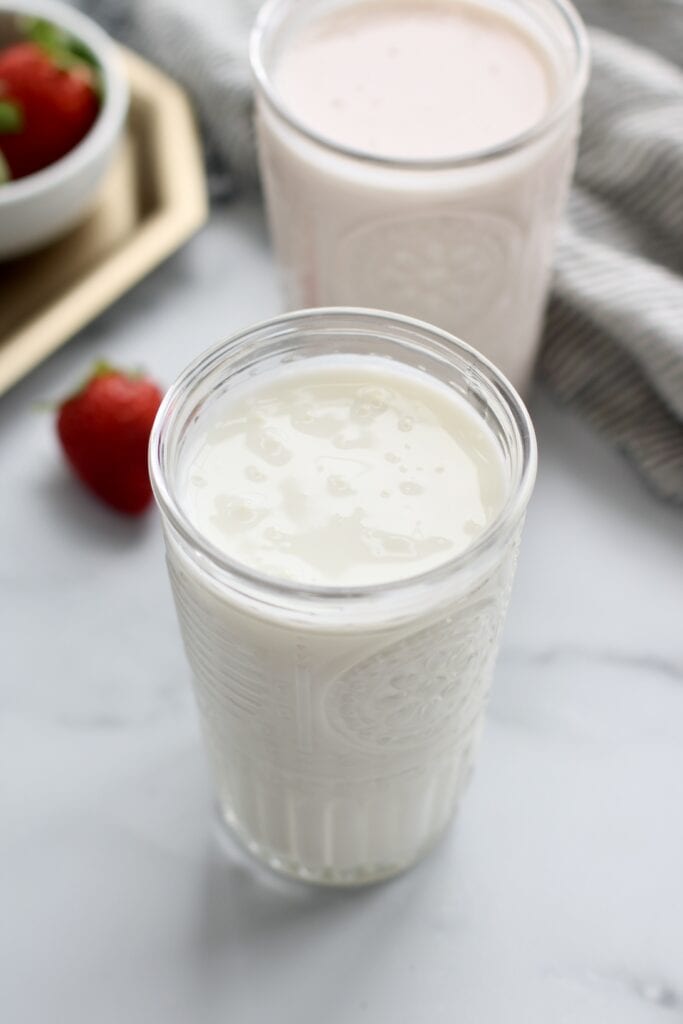
Kefir Types
Kefir can be made with milk, water, coconut water, and various other beverages. You’ll find milk kefir most often in stores.
- Milk kefir: a fermented dairy product made most often from cow’s milk; can be made from sheep or goat’s milk.
- Raw kefir: kefir can be made from raw, unpasteurized milk. You won’t find raw kefir sold in stores because raw milk is illegal to sell and buy in many states. However, some people make raw kefir at home for extra microbiological benefits. Studies show that raw milk kefir contains specific strains of beneficial bacteria and yeasts that don’t occur in kefir made from pasteurized milk.
- Water kefir: a non-dairy fermented beverage made from sugar water, fruit juice, or coconut water.
- Other kefirs: kefir can also be made from coconut milk and other non-dairy plant-based milks, though the fermentation process takes longer and lower amounts of Lactobacillus probiotics are created.
Homemade vs. Store-Bought Kefir
It used to be that kefir was only available at health food stores; otherwise, you’d need to make your own at home. But now, you can find a wide variety of kefir, including kefir milk products and non-dairy kefir products, at nearly every mainstream grocery store.
Making kefir at home isn’t hard to do, but it does take time and care. And it often results in a thinner consistency than store-bought kefir. Traditional kefir made at home with kefir grains will likely have more beneficial bacteria strains than store-bought kefir, which may have been made from powdered cultures or contain added carbonation or unwanted added sugars.
It is very important to use clean and sterilized tools and clean hands when making homemade fermented foods so you don’t introduce harmful pathogenic bacteria into the food. For this reason, it is safer option to purchase store-bought kefir.
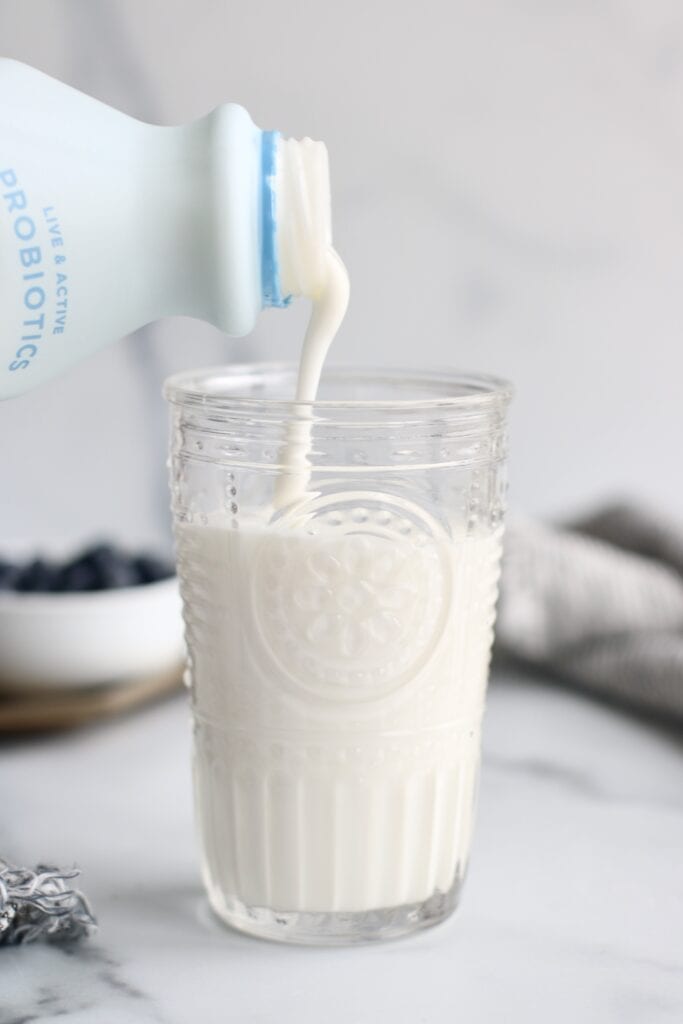
Yogurt vs. Kefir
Though you may see kefir labeled ‘drinkable yogurt,’ it’s not actually yogurt. True, kefir is a fermented food, like yogurt. And it has a similar mildly sweet and tangy taste, like yogurt. But the big difference between yogurt and kefir is the bacterial culture used to make it and the amount of bacterial strains it contains.
Yogurt is typically cultured with 2-3 strains of bacteria. The culture (or ‘kefir grains’) used to make kefir contains as many as 60 different strains of bacteria, plus yeasts. This makes kefir a more diverse probiotic beverage that contains many types of microbes that support gut health and more.Nutritionally, kefir and yogurt are very similar. Kefir contains slightly more calories, protein, fat, and calcium than yogurt, and it contains slightly less sugar than yogurt. Kefir also has a thinner consistency than yogurt, making it more pourable and drinkable than yogurt.
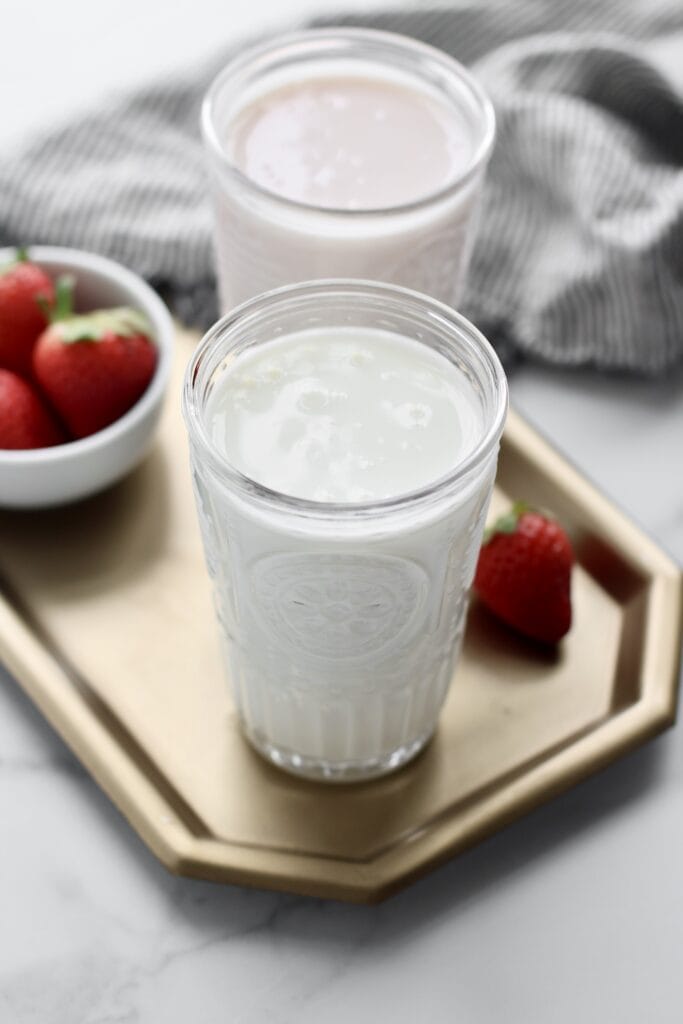
4 Health Benefits of Kefir
Kefir is a probiotic fermented beverage that provides four important health benefits:
1. Improve Digestive Health
Kefir is a rich source of probiotics, and probiotics help the beneficial microorganisms in your gut thrive. A healthy gut microbiome is a great defense against digestive issues, including chronic diarrhea, bloating, and constipation.
The lactic acid bacteria in kefir, which helps break down lactose, also makes the drink easier to digest for people with lactose intolerance.
2. Reduce Inflammation
Probiotics in kefir build your body’s immune system and help fight disease-causing free radicals. One clinical trial showed that kefir may help reduce the inflammatory response to allergies.
3. Protect Your Bones
Kefir is a good source of calcium, a nutrient that’s essential for building and maintaining bone health and lowering the risk of osteoporosis. Kefir also contains magnesium, vitamin B12, which plays a role in calcium metabolism and helps your body absorb more calcium.
4. Lower Your Risk of Infection
Kefir contains a unique probiotic, Lactobacillus kefiri, that has been shown to be very effective at deterring the growth of harmful bacteria that cause infections, such as Salmonella, Helicobacter pylori, Streptococcus, and E. coli.
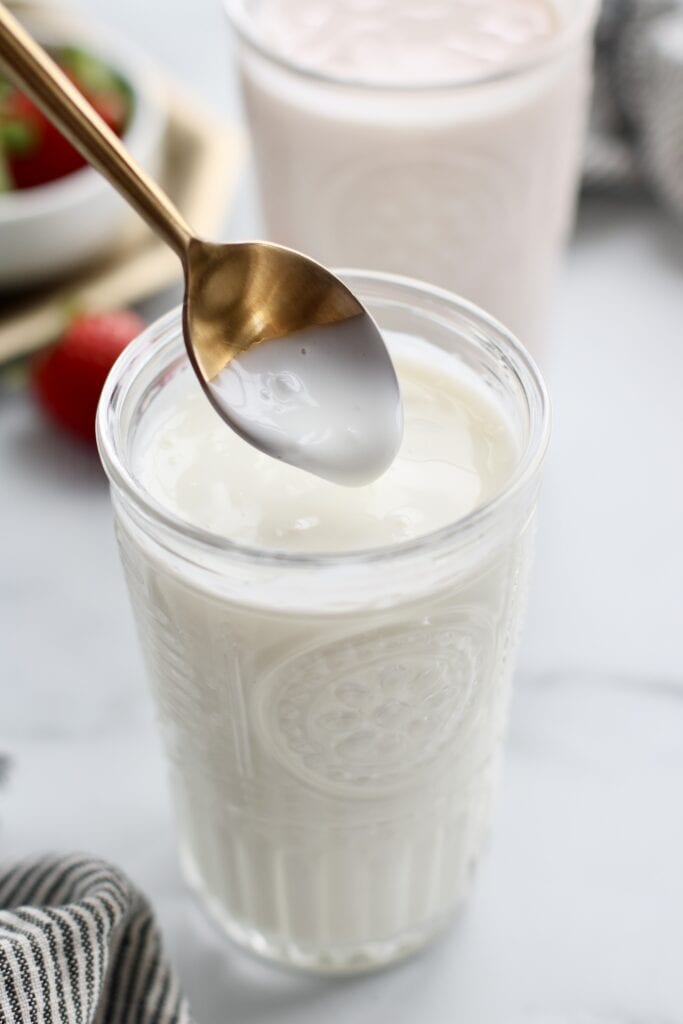
How to Make Homemade Kefir
You can make homemade kefir with basic home items, milk, and kefir grains. Here’s how:
Step 1: Place 1 tablespoon of kefir grains in a 1-quart glass jar. Add 1 cup of grass-fed milk, then cover the jar with something that allows the ingredients to “breathe,” such as a cheesecloth or coffee filter. Hold the cover in place with a rubber band. The bacteria and enzymes need an oxygen-rich environment in order to thrive, so having a breathable cover on the jar is important.
Step 2: Let the jar sit at room temperature (not in an overly chilly or too warm place) for 24 hours. The kefir will be done when it has visibly thickened, has a sour taste, and some white and yellow color separation appears on the surface. This is the curds and whey separating.
Step 3: Pour the mixture through a fine-mesh strainer into a clean jar, pitcher, or bowl. Use the back of a spoon to push the grains (which will look like cottage cheese at this point) against the strainer in order to get out as much liquid as possible. You can drink the kefir immediately, or cover and refrigerate it to enjoy for up to 3 weeks.
Kefir Nutrition Facts
Individual brands vary, but a 1-cup serving of plain, low-fat milk kefir contains about:
- 100-110 calories
- 2 g total fat (1.5 g saturated fat)
- 125 mg sodium
- 9 g total carbohydrates (0 g fiber, 9 g sugars, 0 g added sugars)
- 10 g protein
- 10 mg cholesterol
- 3.8 mcg vitamin D (20%)
- 390 mg calcium (30%)
- 0 mg iron
- 380 mg potassium (8%)
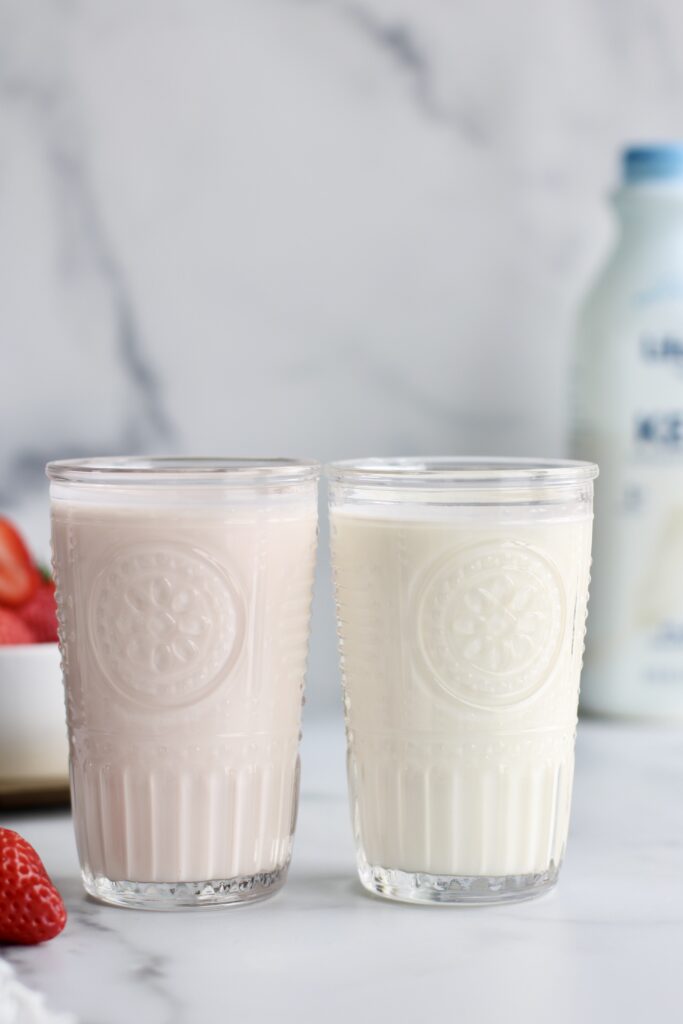
Risks and Dangers
Kefir consumption is safe for most people, but certain people should avoid it:
- Someone with a milk allergy should avoid any kefir made with animal milk. However, non-dairy kefir, such as kefir water, is safe for someone with a milk allergy.
- Immunocompromised people may have an adverse reaction to the high amounts of probiotic bacteria in kefir.
- People undergoing chemotherapy for colon cancer may experience more intestinal side effects, such as stomach pain, when drinking kefir.
Any time you begin consuming more probiotics (from food or supplements), it’s possible that you’ll experience temporary side effects. Drinking kefir can cause temporary side effects like nausea, bloating, cramps, constipation, and diarrhea. Symptoms should abate the longer you drink kefir and consume other probiotic-rich foods and drinks.
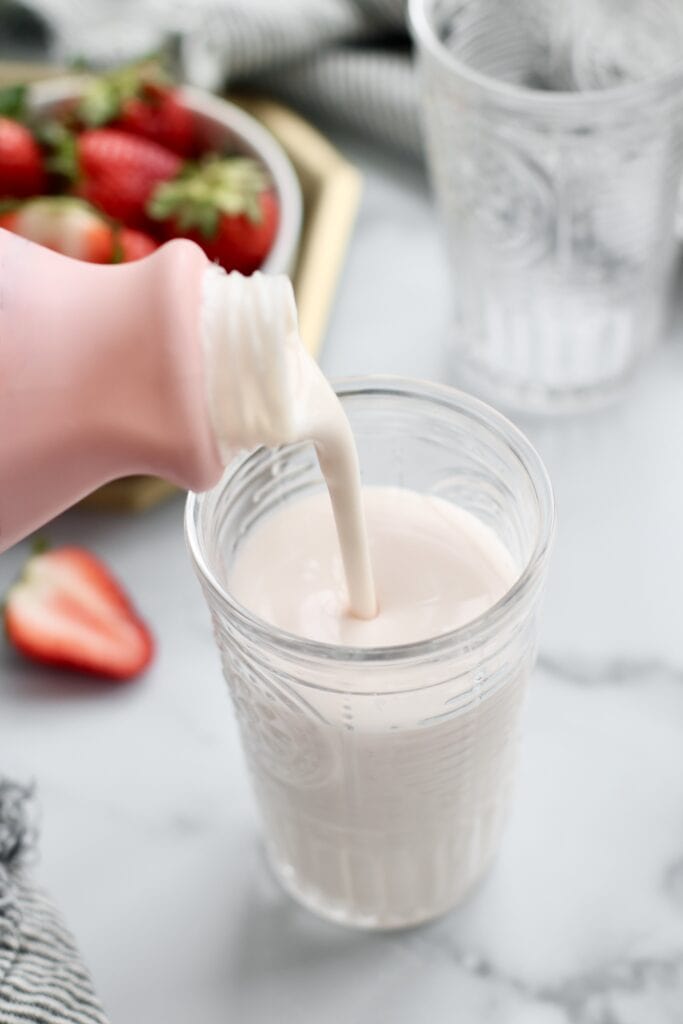
7 Ways To Use Kefir
Not only is kefir great for your gut microbiota, but there are many ways to use it beyond just drinking it as a beverage.
- Drink it – Often referred to as ‘drinkable yogurt,’ kefir is convenient to enjoy, and there’s no spoon needed. Blend plain kefir with your favorite fruit if you want a sweet, fruity flavor without a lot of added sugar.
- Blend it – Blend kefir into your favorite smoothie in place of yogurt. Any leftover smoothie can be frozen in molds to make freezer pops.
- Use in recipes – Use kefir in place of the water, milk, or buttermilk in pancake, waffle, and muffin recipes. Like buttermilk, kefir makes baked goods extra fluffy thanks to the reaction between baking powder and the slightly acidic kefir.
- Add to overnight oats – Give your oats a probiotic boost by mixing them with vanilla or plain kefir before stirring in your favorite fruit, spices, or sweetener.
- Tenderize meats – Give chicken breasts or thighs a quick soak in plain kefir before breading and cooking will make it extra juicy. This technique is much like your great-grandma’s secret recipe for fried chicken soaked in cultured buttermilk.
- Make dressings – Plain kefir is a great way to lighten up creamy salads or add a probiotic punch to salad dressings. Use it in place of yogurt, sour cream, or mayo in condiment recipes.
- Make a dip – In the refrigerator, strain kefir overnight through a coffee filter or cheesecloth. This removes the whey, and what you’re left with is a thick, creamy spreadable dip. Add your favorite herbs or seasonings and enjoy it with crackers and veggies.
Frequently Asked Questions
Milk kefir is a smooth and creamy drink with a slightly sweet and tangy flavor. Some people say it provides a little effervescent tingle on your tongue.
Kefir and yogurt both contain probiotics, however, kefir has more probiotics and a more rich diversity of beneficial probiotics and yeasts.
Someone with a milk allergy should avoid kefir made from animal milk. Additionally, people who are immunocompromised or undergoing chemotherapy should avoid kefir products, as they could contribute to intestinal distress. Always ask your healthcare provider or a local dietitian-nutritionist (RDN) if you want to try kefir but aren’t sure if it’s right for your unique situation.
Yes, most people can drink kefir every day without experiencing health problems. However, if you are immunocompromised, seek medical advice before starting a regular kefir drinking habit.
Historians believe kefir originated in eastern Europe centuries ago in the Caucasus Mountains, near present-day Turkey, although the oldest discovery of kefir is in an ancient tomb in China. The word kefir comes from the Turkish word “keif,” which translates to “good feeling.”
Kefir grains are made by fermenting batches of kefir from existing kefir grains. They can’t be produced synthetically. (Fun fact: The Karachai people, a native people group of the Caucasus area, had legends of the original kefir grains being delivered to them by the prophet Muhammed.)
People pronounce kefir in a few different ways, but the correct pronunciation is kuh-feer.
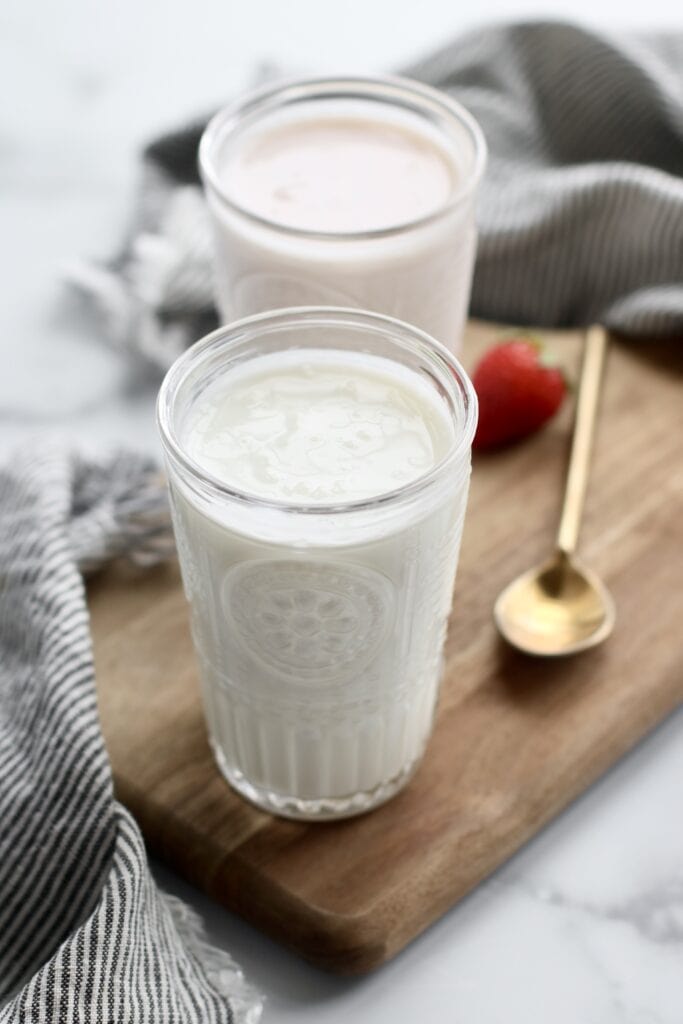
All photos and content are copyright-protected. Please do not use our photos without prior written permission. If you wish to republish a post, please rewrite the article in your own unique words. Link back to the source page here on The Real Food Dietitians. Thank you!
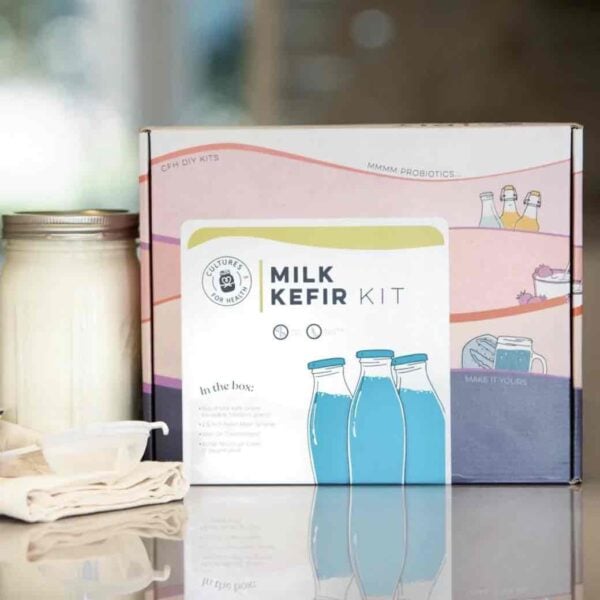

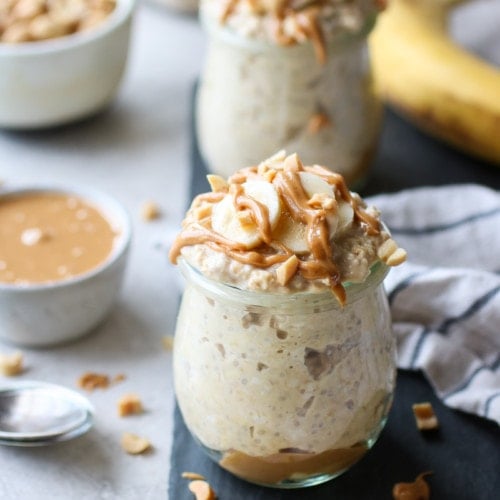
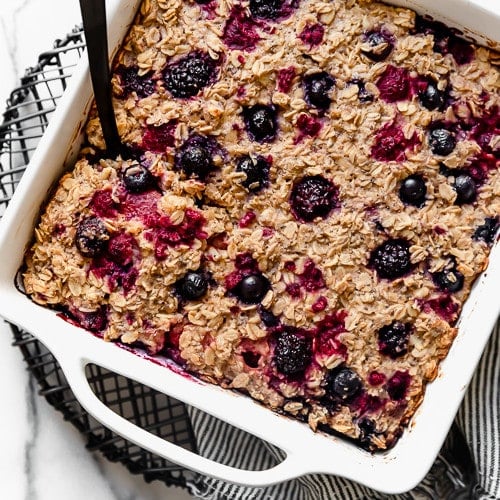
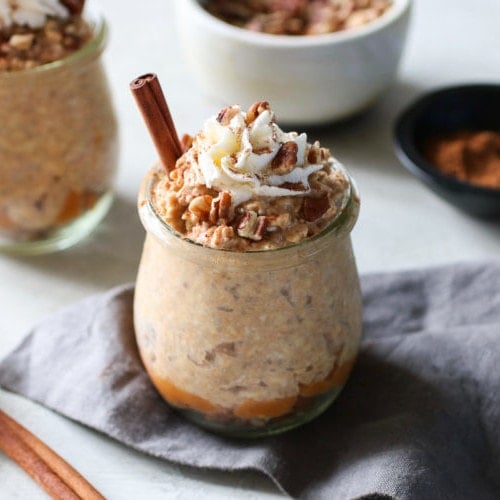
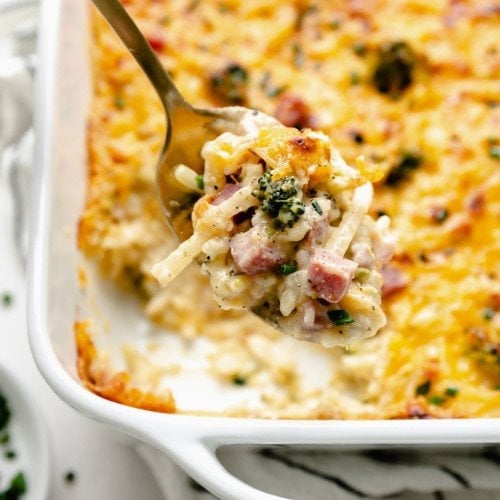
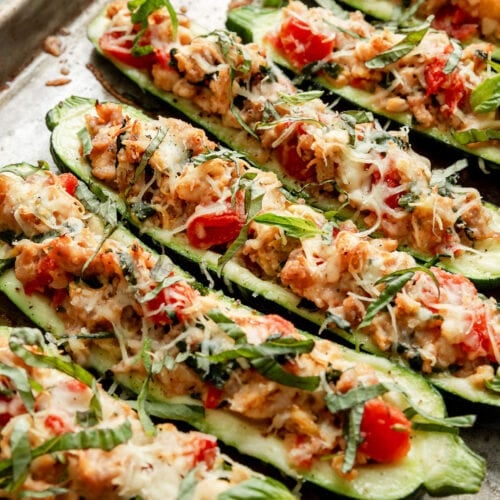
I’ve been hesitant to try kefir because, truthfully, I’ve never really been sure whether it’s a necessary or beneficial part of my diet. You convinced me to give it a try and I’m using it in my morning smoothie with fresh fruit. Anyway, thanks Jessica and keep up the good work — it’s a huge relief to read stuff from a dietitian rather than just relying on what’s in my newsfeed!
Hi Alice,
This is so great to hear! I’m glad that you found this helpful. I remember being a little weirded out the first time I heard of kefir in a health food store in college but then found it to be an excellent addition to smoothies (my hubby likes to make overnight oats with it too).
Hi I’m going to be making your version of baked porridge with kefir. Will the baking kill the probiotic??
Baking (or any heating method for that matter) will kill some of the probiotic bacteria in kefir. However, kefir also contains loads of other important nutrients such as calcium, phosphorous, magnesium, folate, biotin, and vitamins A, B2, B12, D, and K which will not be destroyed during baking.